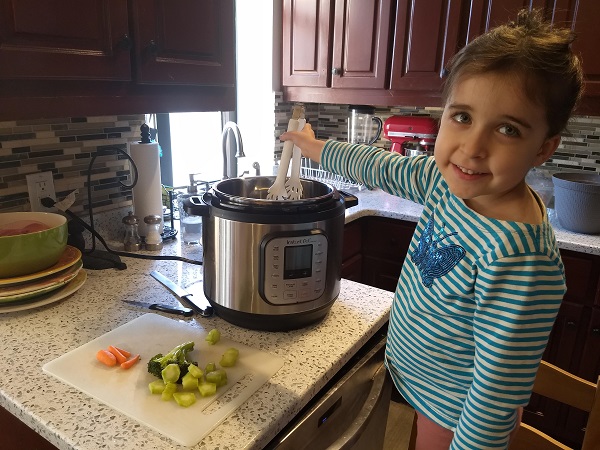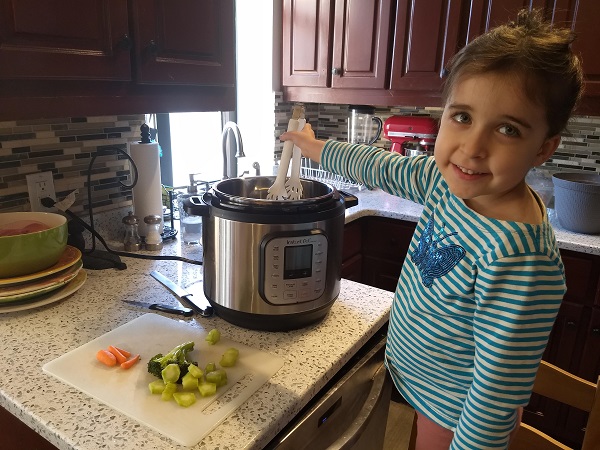
I stared at the Instant Pot box collecting dust in my entryway since Black Friday, simultaneously itching to try it out and terrified that my brief glance through the startup guide would lead to a kitchen explosion with four curious kids underfoot.
It wasn’t until my kids’ first day back in their NYC school building after two weeks of Thanksgiving remote learning that I had the time and mental capacity to read through the owner’s manual. Our few but precious in-person days are a chance for me to reflect, recharge, and think ahead so I’m not throwing chicken nuggets and frozen waffles into the microwave every night.
Like a prep period can do wonders for a teacher’s lesson, an uninterrupted hour Monday morning (plus a pep talk with some fellow moms at school pickup) led to an incredible cooking and learning evening with my children that night. When I mustered up the courage to pressure cook dinner in my Instant Pot, I ended up bringing science and math into the kitchen. By inviting my kids to experiment with me, we applied math and the basics of the scientific method to a very practical and relevant situation—getting dinner on the table.
We planned ahead, gathered materials, made predictions, observed details, took notes on the results, and made adjustments, all while fostering creativity, perseverance, togetherness, and just plain fun!
The COVID-19 pandemic has shifted parenting obligations to include the role of co-teacher while our children learn remotely. Now, more than ever, I intentionally turn everyday moments into opportunities for learning and connecting with my kids. That night, the kitchen became our classroom.
First, I called upon my son to do the math. I handed him the timetable and asked him to find the chicken and see how long it said to cook it for. “It says 6-8 minutes,” my son announced.
“But what about if it’s a lot of chicken?” I wondered aloud. “Will it take longer?” We looked more closely at the chart and discovered that it actually read, “6-8 minutes per pound.” That got us into a discussion about weight and units. I sent him to the fridge to check the label on the chicken, a little mini lesson on its own. We rounded 3.9 lbs. up to 4 and decided to cook half of the chicken. So, we divided 4 by 2 and landed upon 2 lbs. of chicken to cook. My son’s mind digested the numbers and calculated that we should cook the chicken for 12-16 minutes.
Eleven minutes later, afraid the chicken was overcooking, I quickly released the pressure and peered inside. When I cut the chicken breast in half, we noticed how the inside of the chicken was still pink, but the outside had turned white. “By cutting it, we made the inside become the outside,” my son noted. “So now that part should cook fast.”
Our raw chicken incident prompted a series of trial and error experiments. Too pink? Next time we’ll let it coast a few more minutes while the pressure releases naturally. For now, pop it back in for another 5 minutes.
“Can we cook some carrots too?” my daughter asked. We checked the timetable for the suggested cooking time, steamed and tasted some super mushy carrots, and reduced the time variable to 3 minutes before the next round, this time adding broccoli too.
We observed how the steam whistled out of the vent like a volcano when we released the pressure and how the cabinets dripped with water from the steam. We noticed how the broccoli turned a different shade of green if it was below the water line in the pot and that the big stalk turned out firmer than the chopped up one.
How do I know this sacrifice of time and a messy kitchen was all worthwhile? One daughter tried veggies she normally wouldn’t touch. Another offered up a prayer of thanks that night as I tucked her in: “Thank you, God, that we got to do food experiments!” On top of that, my son eagerly offered to sauté onions for soup the next day—even when they made his eyes water.
Now I pray that schools stay open—even if it’s only part-time—so I can swap out hasty dinner prep for a night of culinary adventures every once in a while. When I have an occasional day alone to regroup, I can engage my kids after school with even more meaningful moments together. I need school to be in-person so I can be a better mom at home.











